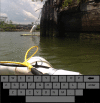Increasing patient engagement in rehabilitation exercises using computer-based citizen science
- PMID: 25793867
- PMCID: PMC4368773
- DOI: 10.1371/journal.pone.0117013
Increasing patient engagement in rehabilitation exercises using computer-based citizen science
Abstract
Patient motivation is an important factor to consider when developing rehabilitation programs. Here, we explore the effectiveness of active participation in web-based citizen science activities as a means of increasing participant engagement in rehabilitation exercises, through the use of a low-cost haptic joystick interfaced with a laptop computer. Using the joystick, patients navigate a virtual environment representing the site of a citizen science project situated in a polluted canal. Participants are tasked with following a path on a laptop screen representing the canal. The experiment consists of two conditions: in one condition, a citizen science component where participants classify images from the canal is included; and in the other, the citizen science component is absent. Both conditions are tested on a group of young patients undergoing rehabilitation treatments and a group of healthy subjects. A survey administered at the end of both tasks reveals that participants prefer performing the scientific task, and are more likely to choose to repeat it, even at the cost of increasing the time of their rehabilitation exercise. Furthermore, performance indices based on data collected from the joystick indicate significant differences in the trajectories created by patients and healthy subjects, suggesting that the low-cost device can be used in a rehabilitation setting for gauging patient recovery.
Conflict of interest statement
Figures





References
-
- Gunasekera WSL, Bendall J (2005) Rehabilitation of neurologically injured patients. In: Neurosurgery, London: Springer; pp. 407–421.
Publication types
MeSH terms
LinkOut - more resources
Full Text Sources
Other Literature Sources
Medical

